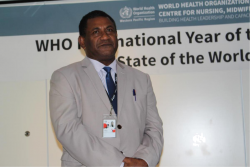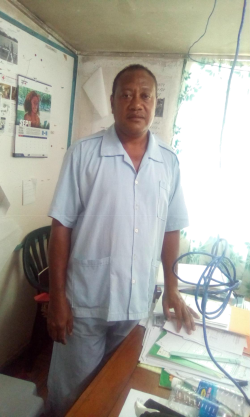Remote Healthcare Outreach Services & Training - Solomon Islands

The WHO CC UTS acknowledges use of key language from The WHO Global Strategic Directions for Nursing and Midwifery (2021–2025).
Over the last 20 years, significant improvements have been made advancing the health status of Solomon Islands residents [1]. The well-trained nursing workforce provides the backbone to service delivery in the remote and rural areas, however long-term strategic planning has been lacking. Nurse leaders, Michael Larui, Gordon Vahilomo and Augustine Bilve have been devoted to addressing the challenges of geography and strategic planning.
Michael Larui is Chief Nurse of the Solomon Islands, based in the Ministry of Health. His goal is to improve the health workforce and deliver better services. Larui is analyzing staff numbers and re-classifying health centres so there’s more standardised care. While the data seems to imply that they do have enough nurses and midwives, Larui laments that in rural and remote communities there is only one health worker whereas there should be two because the expanse they need to cover is so broad.
The Ministry of Health needs to formulate policy for outreach, and I’ve been advocating for increases to outreach services to community for years,
he says.
Augustine Bilve and Gordon Vahimolo are Director & Assistant Director of Nursing for Temotu province in the Solomon Islands. The province stretches across the most eastern part of the country, consisting of two long chains of islands. Together, with 41 nurses and 22 nurse aids, they are responsible for delivering health care to this unique community of 26,000 people. Both Bilve and Vahimolo are based in Lata Hospital, in the capital, a large provincial facility on Santa Cruz Island and oversee 17 other health clinics scattered across the other islands. Some inhabitants are in such remote areas that it takes nurses up to five hours on a small boat to reach them.
Temotu province is quite unique and different from other provinces," he says. “The islands are quite remote and also isolated from each other.

“We always travel by boat”, Bilve says, adding that their visits and the frequency of them are weather-dependent. Sometimes it can be risky, particularly when the weather is rough, which is a common problem between November and April. With big ships visiting the islands every two or three months, he and his teams must travel by smaller boats with outboard motors to reach other islands. The health centre on nearby Reef Island is only a two to 15-minute boat ride away while the longest journey to some of the more remote islands could be up to five hours. The boats can usually only fit around three or four nurses and once they arrive at an island, they stay for one day. The shortage of nurses is another challenge.
I can say that we're the backbone of the health services,” he says. “We cannot meet the demand of what we currently need.
Bilve and his staff are currently in the middle of a measles and rubella vaccination programme after an outbreak of measles in New Zealand. “Most of our staff are going out into remote villages and soon, we will travel to other islands to do the campaign.”
Vahimolo and Bilve are also involved with making sure their nursing staff get support and training. In recent years, they have introduced professional development for staff in the province, starting at Lata hospital. The senior nurses learn about a variety of things, including how to manage staff and units in the hospital, as well as government policies.
We look at is how our supervisors can become effective supervisors and we have covered some training in relation to public service procedures,” he says. He aims to see the nurses “become role models.
Vahimolo also makes sure the right mix of staff with different skills are in the health centres and clinics scattered across the various islands. Sometimes, however, a planned training day will be interrupted when the hospital or health centre becomes too busy with patients. “We need to continuously develop newly qualified nurses … We want to continue to see that they have developed on a daily basis.” Overall, Vahimolo says that health coverage in his province is good.
I would say more than 70 to 80 percent of the population accesses health services,” he says. "Most of the time our nurses are doing live visits and outreach in the community.
However communication services and facilities need to be upgraded. Remoter islands such as Vanikoro and Anuta are in particular need of better services.
[1] Hodge N, Slatyer B, Skiller L. Solomon Islands Health System Review. Vol.5 No.1. Manila: World Health Organization, Regional Office for the Western Pacific, 2015.
